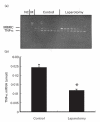Abdominal surgery reduces the ability of rat spleen cells to synthesize and secrete active tumour necrosis factor-alpha (TNF-alpha) by a multilevel regulation
- PMID: 9933416
- PMCID: PMC1905195
- DOI: 10.1046/j.1365-2249.1999.00758.x
Abdominal surgery reduces the ability of rat spleen cells to synthesize and secrete active tumour necrosis factor-alpha (TNF-alpha) by a multilevel regulation
Abstract
We have previously shown that abdominal surgery (explorative laparotomy) reduces the ability of lipopolysaccharide (LPS)-triggered spleen macrophages to secrete TNF-alpha. In this study we characterize possible mechanisms which could be responsible for the reduction in splenic production of TNF-alpha. Post-operative and control (unoperated) rat splenocytes or enriched splenic macrophages were cultured with LPS. Steady-state levels of TNF-alpha mRNA were determined by Northern and slot blot analyses, and validated by quantitative reverse transcriptase-polymerase chain reaction (RT-PCR). The amount of TNF-alpha protein was measured by Western blot analysis, and its biological activity was determined by the fibroblast L-929 cytotoxicity assay. Surgery induced a 12-fold inhibition in TNF-alpha activity (P < 0.02), caused up to two-fold reduction in the accumulation of TNF-alpha mRNA (P < 0.01), and suppressed TNF-alpha protein maturation into its 17-kD form in cellular extracts. Post-surgical spleen supernatants revealed mainly a band of a lower molecular weight (14 kD). Our data suggest a multilevel regulation of post-operative inhibition of TNF-alpha response to LPS, at the accumulation of mRNA, translational and secretory levels. We also suggest that the reduced bioactivity could be partially caused by a proteolytic cleavage of TNF-alpha. Since TNF-alpha is an important participant in immune responses, its reduced production and activity may be a central mechanism of post-operative immunosuppression.
Figures





Similar articles
-
CCK-8 inhibits expression of TNF-alpha in the spleen of endotoxic shock rats and signal transduction mechanism of p38 MAPK.World J Gastroenterol. 2002 Feb;8(1):139-43. doi: 10.3748/wjg.v8.i1.139. World J Gastroenterol. 2002. PMID: 11833090 Free PMC article.
-
Ethanol suppression of the hypothalamic proopiomelanocortin level and the splenic NK cell cytolytic activity is associated with a reduction in the expression of proinflammatory cytokines but not anti-inflammatory cytokines in neuroendocrine and immune cells.Alcohol Clin Exp Res. 2006 Nov;30(11):1925-32. doi: 10.1111/j.1530-0277.2006.00237.x. Alcohol Clin Exp Res. 2006. PMID: 17067358
-
Differential induction of adrenomedullin, interleukins and tumour necrosis factor-alpha by lipopolysaccharide in rat tissues in vivo.Clin Exp Pharmacol Physiol. 2005 Dec;32(12):1110-8. doi: 10.1111/j.1440-1681.2005.04307.x. Clin Exp Pharmacol Physiol. 2005. PMID: 16445578
-
Expression, regulation, and production of tumor necrosis factor-alpha in mouse testicular interstitial macrophages in vitro.Endocrinology. 1993 Dec;133(6):2568-73. doi: 10.1210/endo.133.6.8243279. Endocrinology. 1993. PMID: 8243279
-
Up-regulation of TNF alpha mRNA in the rat spleen following induction of acute pancreatitis.J Surg Res. 1995 Dec;59(6):687-93. doi: 10.1006/jsre.1995.1224. J Surg Res. 1995. PMID: 8538166
Cited by
-
CCK-8 inhibits expression of TNF-alpha in the spleen of endotoxic shock rats and signal transduction mechanism of p38 MAPK.World J Gastroenterol. 2002 Feb;8(1):139-43. doi: 10.3748/wjg.v8.i1.139. World J Gastroenterol. 2002. PMID: 11833090 Free PMC article.
-
The Effect of High-Fat Diet and Exercise Intervention on the TNF-α Level in Rat Spleen.Front Immunol. 2021 Dec 15;12:671167. doi: 10.3389/fimmu.2021.671167. eCollection 2021. Front Immunol. 2021. PMID: 34975827 Free PMC article.
-
The involvement of matrix metalloproteinases 2 and 9 in rat retinal ischemia.Graefes Arch Clin Exp Ophthalmol. 2007 May;245(5):725-32. doi: 10.1007/s00417-006-0362-y. Epub 2006 Oct 6. Graefes Arch Clin Exp Ophthalmol. 2007. PMID: 17024442
-
MMP expression in leaking filtering blebs and tears after glaucoma filtering surgery.Graefes Arch Clin Exp Ophthalmol. 2011 Jul;249(7):1047-55. doi: 10.1007/s00417-011-1658-0. Epub 2011 Mar 31. Graefes Arch Clin Exp Ophthalmol. 2011. PMID: 21452038
References
-
- Hadjiminas DJ, McMasters KM, Peyton JC, Cheadle WG. Tissue tumor necrosis factor mRNA expression following cecal ligation and puncture of intraperitoneal injection of endotoxin. J Surg Research. 1994;56:549–55. - PubMed
-
- Beutler B, Cerami A. Tumor necrosis, cachexia, shock and inflammation: a common mediator. Ann Rev Biochem. 1988;57:505–18. - PubMed
-
- Tracey KJ, Cerami A. Tumor necrosis factor: a pleoitropic cytokine and therapeutic target. Ann Rev Med. 1994;45:491–503. - PubMed
-
- Pirenne J, Riobbens C, Medot M, et al. Adverse effects of abdominal operations on production of interferon-gamma. Eur J Surg. 1995;161:77–83. - PubMed
Publication types
MeSH terms
Substances
LinkOut - more resources
Full Text Sources
Other Literature Sources

